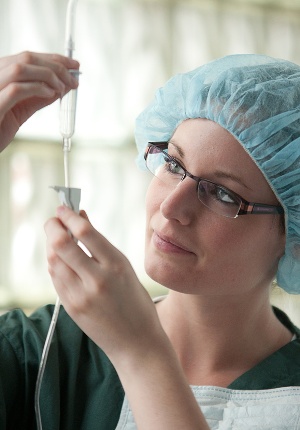Before actually moving on to the job description one might ask “What is an LPN”? The abbreviation “LPN” stand for Licensed Practical Nurse. In some states, the abbreviation LVN is also used which stands for Licensed Vocational Nurse. These are health professionals that work under the supervision of the Registered Nurse (RN) and Physician.
An educational program for LPN generally takes on 12 to 18 months in an average LPN school, which is a quick way to gain a career in the nursing field. LPNs are limited to certain duties in the hospital setting because their educational training isn’t as specific and comprehensive as that of the RN. Although their duties in the hospital are limited by their license and training, LPNs are highly competent and could further advance the RN status sometime in the future if the individual is interested in pursuing it.
 The LPN job description consists primarily of tasks for patients in the hospital that have fairly stable medical conditions and have predictable outcomes. The more critical patients are assigned to a registered nurse because of their more advanced and critical training. LPNs are provided with basic nursing skills and generally learn the following:
The LPN job description consists primarily of tasks for patients in the hospital that have fairly stable medical conditions and have predictable outcomes. The more critical patients are assigned to a registered nurse because of their more advanced and critical training. LPNs are provided with basic nursing skills and generally learn the following:
- Anatomy and Physiology
- Basic Nursing skills / procedures
- Nutrition
- Medical-surgical Nursing
- Pediatric Nursing
- Obstetric Nursing
- Emergency Care
 The specific LPN tasks usually include the following:
The specific LPN tasks usually include the following:
- Taking vital signs for patients with predictable outcomes (blood pressure reading, pulse rate, respiratory rate and temperature)
- Monitoring the height and weight
- Collect urine and stool samples
- Procedures for stable patients such as tracheostomy care, nasogastric suctioning, colostomy care, pressure ulcer dressings (depending on the degree of damage)
- Giving medications via oral route, intramuscular (IM) route, subcutaneous (SQ) route (IV administration for LPNs depend on each state, some states allow IV certification for LPNs and some hospitals provide training for their LPNs)
- Monitoring the patient after the administration of medications (depending on the medication given)
- Sterile dressing changes and bandage changes for patients that are stable
- Preparation and administration of enemas
- Monitoring catheters and food intake and output
- Providing massages and rubs for patients that are stable
- Monitoring patients and reporting changes to the RN and Physician
- Providing patient hygiene
- Assisting the RN in procedures
- Experienced LPNs may supervise Certified Nursing Assistants (CNAs)
- Providing the patient or family with general and basic health teaching about modifications in lifestyles (RNs are the ones that are entitled to provide the more in-depth health teaching about risk factors and about certain diseases, Physicians give the diagnosis, information for surgery and options a patient may choose from)
- LPNs can work in a doctor’s office and help make appointments and keep patient’s records and do other clerical work
The LPN job consists of duties and tasks around the hospital that require competency and skill but within the level of the LPN”s training. The required training in LPN schools and programs ensure the provision of excellent nursing skills and procedures for patients in the hospital. Although the RN has more responsibilities in the hospital, LPNs are also vital in the workplace and handle many of the less demanding tasks and thus ensuring that the RN’s time is available for the higher level tasks. The RN can delegate many tasks to the LPN to organize their work load and provide high-quality patient care. In fact if you are interested in advancing your career there are many LPN to RN programs available.

Comments
LPN Job Description — No Comments
HTML tags allowed in your comment: <a href="" title=""> <abbr title=""> <acronym title=""> <b> <blockquote cite=""> <cite> <code> <del datetime=""> <em> <i> <q cite=""> <s> <strike> <strong>